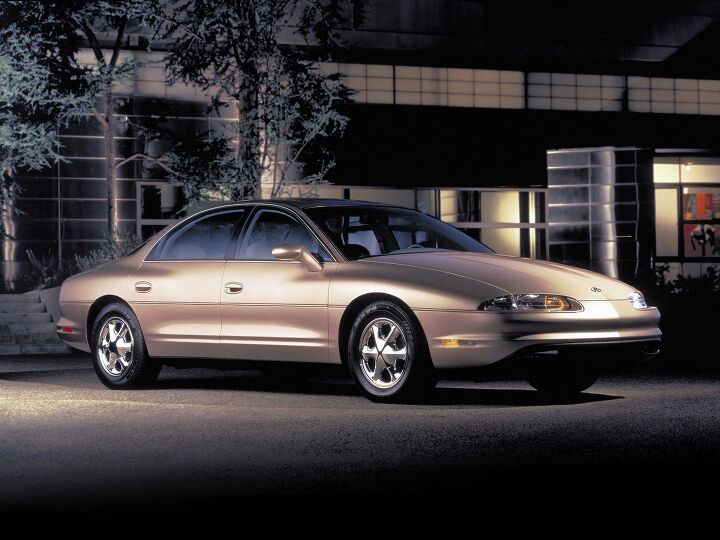#SatelliteNavigation
Abandoned History: Oldsmobile's Guidestar Navigation System and Other Cartography (Part VI)
Sacrificing much, GM spent billions and billions of 1980s dollars on technology and engineering entities at the behest of CEO Roger Smith, who wanted to transform The General into a company more resembling a conglomerate like GE. Half a decade later Smith was gone, and the remaining brass began to unwind the costly EDS and Hughes deals and return GM to its standard operating procedure. But behind the layers of finance and paperwork, Guidestar GPS was developed. And the first time the public got to see it was in 1994 in a very exciting debut.
Abandoned History: Oldsmobile's Guidestar Navigation System and Other Cartography (Part V)
As we learned in our last installment in this series, the lowering of the digital and governmental barrier between civilian and military GPS assets in 1996 was a boon to the consumer side of navigation, and (per our comments) land surveying as well. It was a timely turn of events for General Motors after the Orlando area TravTek experiment of 1992 proved either too costly to scale, or alternatively not valuable enough in the eyes of consumers. Before we get to GuideStar, we need to cover much context around why GM was so keen on high-tech things in the Nineties, and the massive amounts of money it spent in its pursuit.
Abandoned History: Oldsmobile's Guidestar Navigation System and Other Cartography (Part IV)
General Motors spent a lot of time and money in the development of TravTek GPS. As we learned in our last installment, the comprehensive (if clunky) navigation system used a touchscreen, had live traffic information, and could even make phone calls. Installed in 100 Toronados used in the greater Orlando area for an entire year, GM, AAA, and various government parties were eager to see just how useful the system was and if it was worthwhile. Narrator: It wasn’t. Let’s find out why.
Abandoned History: Oldsmobile's Guidestar Navigation System and Other Cartography (Part III)
We return to our spicy Oldsmobile content this week, with the introduction of GM’s first publicly tested in-car navigation system, TravTek. Arriving in the early Nineties, TravTek was launched more than two decades after GM’s magnet-based DAIR prototype failed to make production. This time The General was determined to make good on their big investment. Onward, to Orlando!
Abandoned History: Oldsmobile's Guidestar Navigation System and Other Cartography (Part II)
In last week’s installment of Abandoned History, we learned about General Motors’ 1966 magnet-based primitive navigation system, DAIR. The inclusive system featured emergency messages, traffic bulletins played inside the car, and route guidance. DAIR never progressed beyond the concept stage and two total test vehicles, largely because it would have meant buried magnets and accompanying signal relay stations at every major intersection in the country. Some 25 years later The General tried it again, but technology progressed considerably by that point.
Abandoned History: Oldsmobile's Guidestar Navigation System and Other Cartography (Part I)
GM’s exclusive Guidestar navigation was available on a select handful of early 90s Oldsmobiles for a very short period of time. Gone as quickly as it arrived, the expensive system was at the forefront of in-car automotive navigation. Believe it or not, it was Oldsmobile that offered the very first navigation system for a passenger vehicle in the North American market. But what happened to Guidestar that led it to be featured here at Abandoned History? The tale begins in 1966, with a genius idea.
Study: Using Satellite Navigation Shuts Down Parts of Your Brain
A new study suggests drivers who follow GPS directions regularly do not engage their hippocampus, highly limiting the development of an internal map and making them more dependent on navigation devices. We’ve all heard accounts of London cabbies with juicy, swollen central lobes, stemming from the requisite training and memorization of city streets and landmarks. It turns out the inverse may also be true. This may be another classic case of if you don’t use it, you lose it.
The University College London discovered the hippocampus (used for direction and memory) and the prefrontal cortex (used for decision-making) both saw elevated levels of activity whenever drivers turned down unfamiliar streets or had free-choice to follow along their route. However, those making use of navigational systems produced no additional activity in those areas whatsoever. Zero, zilch, nada.






















Recent Comments